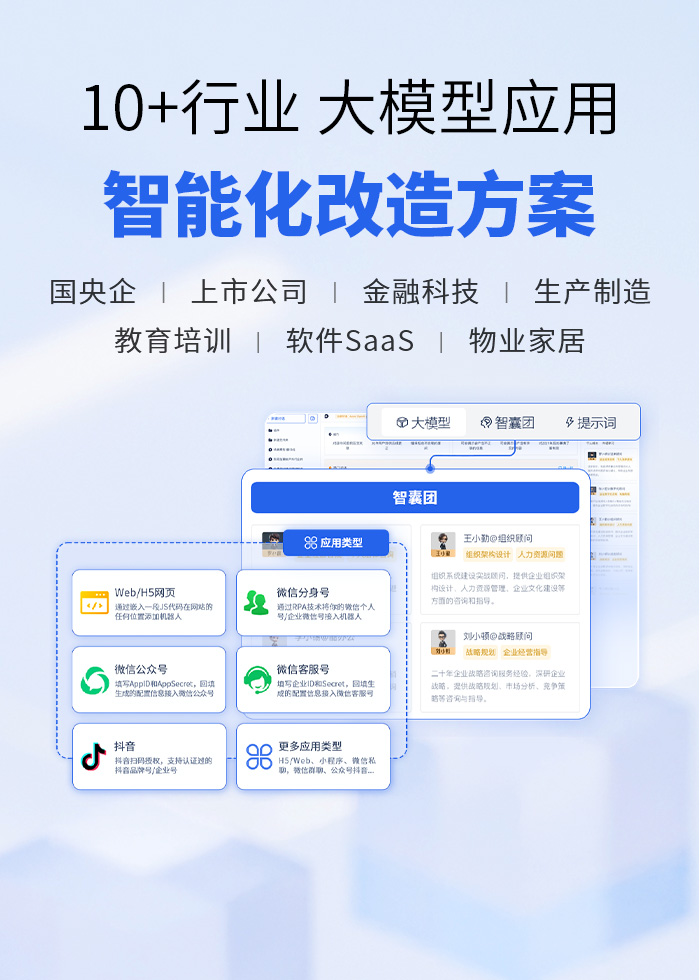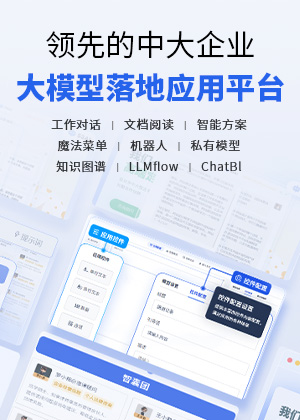微软继今年4月推出Phi-3系列小型语言模型后,又一鼓作气三连发布并开源其「小而美」系列 Phi-3.5模型!
本次发布的三个模型各有特色:
Mini型:Phi-3.5-mini-instruct(3.8B)
Phi-3.5 mini 具有 38 亿个参数,基于Phi-3 的数据集(合成数据和经过筛选的公开网站)构建,重点关注高质量、推理密集的数据。该模型属于 Phi-3 模型系列,支持 128K 令牌上下文长度。该模型经过了严格的增强过程,结合了监督微调、近端策略优化和直接偏好优化,以确保精确遵守指令和强大的安全措施。Phi-3.5 mini 在中文场景有所增强,但是受限于模型的大小,依然会有较多的事实错误,通过RAG的方式可以有效降低错误。
MoE型:Phi-3.5-MoE-instruct (16x3.8B)
Phi-3.5-MoE-instruct是一个MoE模型,有 16x3.8B 个参数,使用 2 位专家时有 6.6B 个活动参数。该模型使用词汇量为 32,064 的标记器。Phi-3.5-MoE-instruct在推理能力上大大增强(尤其是数学和逻辑),也非常适用于function call的场景。
多模态:Phi-3.5-vision-instruct (4.2B)
Phi-3.5-vision-instruct 多模态版本可支持 128K 上下文长度(以 token 为单位)有 4.2B 参数,主要包含图像编码器和 Phi-3 Mini 语言模型。本次Phi-3.5-vision-instruct 支持多图理解,在如下场景上有较好的效果:
一般图像理解;
光学字符识别 (OCR)
图表和表格理解;
多幅图像比较;
多图像或视频片段摘要
同时魔搭社区已经上线Phi-3.5-mini-instruct-GGUF,可更加方便的使用ollama,llama.cpp,lmstudio等工具运行。
模型链接:
Phi-3.5-mini-instruct:
https://modelscope.cn/models/LLM-Research/Phi-3.5-mini-instruct
Phi-3.5-MoE-instruct:
https://modelscope.cn/models/LLM-Research/Phi-3.5-MoE-instruct
Phi-3.5-vision-instruct :
https://modelscope.cn/models/LLM-Research/Phi-3.5-vision-instruct
Phi-3.5-mini-instruct-GGUF:
https://modelscope.cn/models/LLM-Research/Phi-3.5-mini-instruct-GGUF
cookbook链接:
https://github.com/microsoft/Phi-3CookBook
Phi-3.5-mini-instruct
小模型Phi-3.5-mini-instruct在中文能力上有更好的支持。
import torchfrom modelscope import AutoModelForCausalLM, AutoTokenizerfrom transformers import pipelinetorch.random.manual_seed(0)model = AutoModelForCausalLM.from_pretrained("LLM-Research/Phi-3.5-mini-instruct",device_map="cuda",torch_dtype="auto",trust_remote_code=True,)tokenizer = AutoTokenizer.from_pretrained("LLM-Research/Phi-3.5-mini-instruct")messages = "<|system|>\n 你是我的人工智能助手,协助我用中文解答问题.\n<|end|><|user|>\n 你知道长沙吗?? \n<|end|><|assistant|>"pipe = pipeline("text-generation",model=model,tokenizer=tokenizer,)generation_args = {"max_new_tokens": 500,"return_full_text": False,"temperature": 0.0,"do_sample": False,}output = pipe(messages, **generation_args)print(output[0]['generated_text'])
Phi-3.5-vision-instruct
多模态模型Phi-3.5-vision-instruct支持了多图理解
from PIL import Imageimport requestsfrom transformers import AutoModelForCausalLMfrom transformers import AutoProcessorfrom modelscope import snapshot_downloadmodel_id = snapshot_download("LLM-Research/Phi-3.5-vision-instruct")# Note: set _attn_implementation='eager' if you don't have flash_attn installedmodel = AutoModelForCausalLM.from_pretrained(model_id,device_map="cuda",trust_remote_code=True,torch_dtype="auto",_attn_implementation='flash_attention_2')# for best performance, use num_crops=4 for multi-frame, num_crops=16 for single-frame.processor = AutoProcessor.from_pretrained(model_id,trust_remote_code=True,num_crops=4)images = []placeholder = ""# Note: if OOM, you might consider reduce number of frames in this example.for i in range(1,20):url = f"https://modelscope.oss-cn-beijing.aliyuncs.com/resource/Introduction-to-Microsoft-Azure-Cloud-{i}-2048.webp"images.append(Image.open(requests.get(url, stream=True).raw))placeholder += f"<|image_{i}|>\n"messages = [{"role": "user", "content": placeholder+"Summarize the deck of slides."},]prompt = processor.tokenizer.apply_chat_template(messages,tokenize=False,add_generation_prompt=True)inputs = processor(prompt, images, return_tensors="pt").to("cuda:0")generation_args = {"max_new_tokens": 1000,"temperature": 0.0,"do_sample": False,}generate_ids = model.generate(**inputs,eos_token_id=processor.tokenizer.eos_token_id,**generation_args)# remove input tokensgenerate_ids = generate_ids[:, inputs['input_ids'].shape[1]:]response = processor.batch_decode(generate_ids,skip_special_tokens=True,clean_up_tokenization_spaces=False)[0]print(response)
Phi-3.5-MoE-instruct
Phi-3.5-MoE-instruct模型推理能力更强,本文演示的为agent场景
import torchfrom transformers import AutoModelForCausalLM, AutoTokenizer, pipelinefrom modelscope import snapshot_downloadmodel_dir = snapshot_download("LLM-Research/Phi-3.5-MoE-instruct")torch.random.manual_seed(0)model = AutoModelForCausalLM.from_pretrained(model_dir,device_map="cuda",torch_dtype="auto",trust_remote_code=True,)tokenizer = AutoTokenizer.from_pretrained(model_dir)pipe = pipeline("text-generation",model=model,tokenizer=tokenizer,)generation_args = {"max_new_tokens": 500,"return_full_text": False,"temperature": 0.0,"do_sample": False,}
设置system message
sys_msg = """You are a helpful AI assistant, you are an agent capable of using a variety of tools to answer a question. Here are a few of the tools available to you:- Blog: This tool helps you describe a certain knowledge point and content, and finally write it into Twitter or Facebook style content- Translate: This is a tool that helps you translate into any language, using plain language as requiredTo use these tools you must always respond in JSON format containing `"tool_name"` and `"input"` key-value pairs. For example, to answer the question, "Build Muliti Agents with MOE models" you must use the calculator tool like so:```json{"tool_name": "Blog","input": "Build Muliti Agents with MOE models"}```Or to translate the question "can you introduce yourself in Chinese" you must respond:```json{"tool_name": "Search","input": "can you introduce yourself in Chinese"}```Remember just output the final result, ouput in JSON format containing `"agentid"`,`"tool_name"` , `"input"` and `"output"` key-value pairs .:```json[{ "agentid": "step1","tool_name": "Blog","input": "Build Muliti Agents with MOE models","output": "........."},{ "agentid": "step2","tool_name": "Search","input": "can you introduce yourself in Chinese","output": "........."},{"agentid": "final""tool_name": "Result,"output": "........."}]```The users answer is as follows."""
def instruction_format(sys_message: str, query: str):# note, don't "</s>" to the endreturn f'<|system|> {sys_message} <|end|>\n<|user|> {query} <|end|>\n<|assistant|>'
query ='Write something about Generative AI with MOE , translate it to Chinese'input_prompt = instruction_format(sys_msg, query)import osos.environ["PYTORCH_CUDA_ALLOC_CONF"] = "expandable_segments:True "output = pipe(input_prompt, **generation_args)output[0]['generated_text']
显存占用:
Phi-3.5-mini-instruct-GGUF
使用Ollama本地运行Phi-3.5-mini-instruct-GGUF
Linux环境使用
下载GGUF模型:
modelscope download --model=LLM-Research/Phi-3.5-mini-instruct-GGUF --local_dir . Phi-3.5-mini-instruct-Q5_K_M.gguf
Liunx用户可使用魔搭镜像环境安装【推荐】
modelscope download --model=modelscope/ollama-linux --local_dir ./ollama-linuxcd ollama-linuxsudo chmod 777 ./ollama-modelscope-install.sh./ollama-modelscope-install.sh
启动Ollama服务
ollama serve创建ModelFile
复制模型路径,创建名为“ModelFile”的meta文件,内容如下:
FROM /mnt/workspace/Phi-3.5-mini-instruct-Q5_K_M.ggufTEMPLATE """{{ if .System }}<|system|>{{ .System }}<|end|>{{ end }}{{ if .Prompt }}<|user|>{{ .Prompt }}<|end|>{{ end }}<|assistant|>{{ .Response }}<|end|>"""
创建自定义模型
使用ollama create命令创建自定义模型
ollama create myphi3_5 --file ./Modelfile运行模型
ollama run myphi3_5显存占用:
我们使用ms-swift对LLM: Phi-3.5-mini-instruct, VLM: Phi-3.5-vision-instruct进行微调。swift是魔搭社区官方提供的大模型与多模态大模型微调推理框架。
ms-swift开源地址:https://github.com/modelscope/ms-swift
环境准备
git clone https://github.com/modelscope/swift.gitcd swiftpip install -e .[llm]# 可选, 对phi3_5-mini-instruct进行推理加速.pip install vllm
LLM微调
这里我们使用alpaca-zh, alpaca-en作为示例数据集,展示可运行的demo。
您可以在modelscope上这两个数据集:
-
alpaca-zh:
https://modelscope.cn/datasets/AI-ModelScope/alpaca-gpt4-data-zh
-
alpaca-en:
https://modelscope.cn/datasets/AI-ModelScope/alpaca-gpt4-data-en
自定义数据集参考:https://swift.readthedocs.io/zh-cn/latest/LLM/%E8%87%AA%E5%AE%9A%E4%B9%89%E4%B8%8E%E6%8B%93%E5%B1%95.html
微调脚本:
# 显存占用: 4 * 11GB# 以下脚本分别采样alpaca-zh, alpaca-en数据集20000条# 更多超参数含义可以查看文档CUDA_VISIBLE_DEVICES=0,1,2,3 NPROC_PER_NODE=4 swift sft \--model_type phi3_5-mini-instruct \--model_id_or_path LLM-Research/Phi-3.5-mini-instruct \--sft_type lora \--learning_rate 1e-4 \--output_dir output \--dataset alpaca-zh#20000 alpaca-en#20000 \--lora_target_modules ALL \--deepspeed default-zero2
微调后推理脚本:
# 推理CUDA_VISIBLE_DEVICES=0 swift infer \--ckpt_dir output/phi3_5-mini-instruct/vx-xxx/checkpoint-xxx \--load_dataset_config true# merge-lora 并使用vllm进行加速CUDA_VISIBLE_DEVICES=0 swift infer \--ckpt_dir output/phi3_5-mini-instruct/vx-xxx/checkpoint-xxx \--load_dataset_config true --merge_lora true \--infer_backend vllm
VLM微调
这里我们使用coco-en-mini作为示例数据集,该数据集的任务是对图片内容进行描述,展示可运行的demo。
您可以在 modelscope上找到该数据集:https://modelscope.cn/datasets/modelscope/coco_2014_caption/summary
自定义数据集格式如下(单图、多图和无图):
{"query": "<image>55555", "response": "66666", "images": ["image_path"]}{"query": "eeeee<image>eeeee<image>eeeee", "response": "fffff", "history": [], "images": ["image_path1", "image_path2"]}{"query": "EEEEE", "response": "FFFFF", "history": [["query1", "response2"], ["query2", "response2"]], "images": []}
微调脚本:
# 显存占用: 4 * 12GB# 默认会将lora_target_modules设置为llm和projector所有的linearCUDA_VISIBLE_DEVICES=0,1,2,3 NPROC_PER_NODE=4 swift sft \--model_type phi3_5-vision-instruct \--model_id_or_path LLM-Research/Phi-3.5-vision-instruct \--sft_type lora \--dataset coco-en-mini#20000 \--deepspeed default-zero2
如果要使用自定义数据集,只需按以下方式进行指定:
--dataset train.jsonl \--val_dataset val.jsonl \
显存占用:
训练loss图(时间原因,只训练了450个step):
微调后推理脚本如下:
# 推理CUDA_VISIBLE_DEVICES=0 swift infer \--ckpt_dir output/phi3_5-vision-instruct/vx-xxx/checkpoint-xxx \--load_dataset_config true# merge-lora并推理CUDA_VISIBLE_DEVICES=0 swift infer \--ckpt_dir output/phi3_5-vision-instruct/vx-xxx/checkpoint-xxx \--load_dataset_config true --merge_lora true \--safe_serialization false
微调后模型对验证集进行推理的示例:
点击阅读原文,跳转Phi-3.5模型合集页~
来见面吧!
9.19-9.21,魔搭社区邀你相聚云栖小镇
逛展,聊天,交个朋友
即日起 免费领票,数量有限噢 ?
(通过本渠道注册,可凭报名记录前往魔搭展区领取限定周边礼品一份)

































 粤ICP备14082021号
粤ICP备14082021号